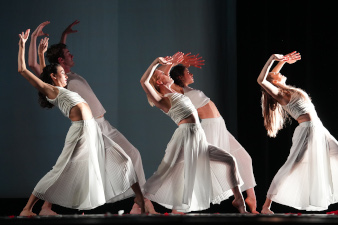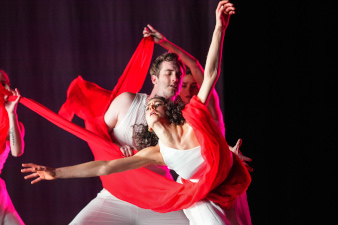
Barney Yates
GREEK
TO ME On November 18, 2022 Alessandra Corona Performing Works
celebrated its 10th Anniversary Season with the premiere of "Klytaimnestra,"
choreographed by Ms. Corona in collaboration with the company.
Set to "Proseccio," an original (largely percussive) score
by Thomas Lentakis, it took stage in the ample seating and large proscenium
stage of JREC
This new full length dance production was inspired by the Greek tragedy of the house of Atreus (also known as the Oresteia). Choreography by Corona and her company was said to explore the psychological and emotional aspects of the story and the conflicts and passions of the characters. I'll go along with that, because what I saw was certainly not narrative or literal to the myth. Of course, what can you call "literal"? -- there's no definitive version of any myth, just like there's no "authentic astrology," since just about every civilization from Sumer to China has its own search for human meaning in the sky. In the various versions of this eternal story, Agamemnon sacrifices his daughter, Iphigenia, to Artemis in order for his fleet, becalmed at Aulis, to gain a favorable wind and sail to Troy. Upon his return, he is killed in his bath by his wife, Klytaimnestra (with or without the help of her lover, Aegisthus). Klytaimnestra (often written as Clytemnestra) is seen as an agent of the curse on Agamemnon’s family, the House Atreus. Her role in the myth is variously interpreted as a revenge story, a commentary on the value of sacrifice, or a lesson on adultery. In this evening of dance, Corona gives us the story in 11 scenes. These show abduction of Klytaimnestra, celebrations preceding the launch to Troy (including the announcement of Ihigenia's marriage to Achilles), the sacrifice of Iphigenia, a Trojan war scene, Klytaimnestra anxiously awaiting Agamemnon's return, which he does with Cassandra as his concubine; the murder of Agamemnon and Cassandra, a duet of Orestes and Electra when they plan to kill Klytaimnestra, the actual murder of the queen and the ensuing death of Electra.
There was plenty to like. The vocabulary was ballet-based and contemporary. Nothing classical, although (pun intended), the subject matter is. There were interesting lifts by men who were good partners. All in all, it was well-directed and quite committed. I have seen Corona take the limelight in other concerts; this time, she passed it on to her dancers, who all had good connections with each other. We saw real relationships and real emotions--Corona seems to always show us something human. Sometimes, what we saw was just love of movement. The percussive-heavy score by Thomas Lentakis won my admiration; Corona was obviously inspired by it. My notes contain kudos to women of the troupe for their exciting back bends, a recurring movement that I marveled at. The splendor and excitement of royal life was suggested by minimalist touches, like a billowing white sheet that was sometimes furled over the dancers and at one point, became a banquet table.
The cast was: Special Guest Advisor was Michael Mao. Light & Sound Designer was Robert Virzera. Costume Creator was Alessandra Corona. |
| museums | NYTW mail | recordings | coupons | publications | classified |



